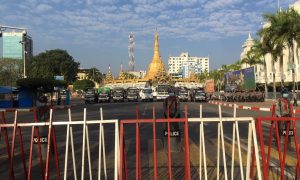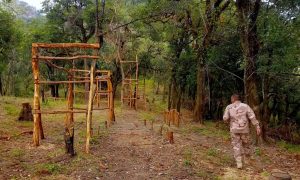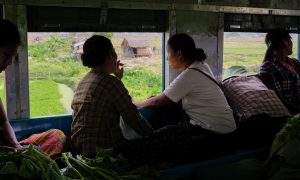This post is an abridged version of an article that appears in a forthcoming special edition of the Journal of Contemporary Asia on “Revolution and Solidarity in Myanmar” (54:5).
______
On 15 June 2024 over 200 prisoners—including 60 women—were transferred from prisons in Mon State and Mandalay to alternative locations in a bid to disrupt anticipated “flower protests”. These were expected in connection with the 79th birthday of Myanmar’s deposed state counsellor Aung San Suu Kyi. On arrival in Daiku prison in Bago Region some of the transferred prisoners discovered their personal items, including food provided by their families, had been confiscated.
Their demands to have their goods returned escalated into a protest that included other political and ordinary prisoners already held in the prison. In response, prisoners were verbally abused, threatened with rape, beaten with sticks and batons, and fired on with slingshots. The Political Prisoners Network Myanmar, an NGO, told reporters that many were injured as a result, some requiring hospital treatment. Those not hospitalised were locked in solitary confinement as punishment.
A month earlier, on 16 May, 98 prisoners were freed when Buthidaung Prison in Rakhine state was liberated amid ongoing fighting between the Myanmar military and the Arakan Army (AA). Over a few days the Myanmar military’s strategic command and other military outposts were also taken over by AA. The families of 31 political prisoners were contacted and provision made for them to return home.
These two events exemplify the role prisons play in the unfolding revolutionary situation in Myanmar. As in the past, prisons have become key sites of repression and resistance, a focal point for gross violations of human rights, and a focal point of protest and potential liberation. Since the coup prisons have been used to incapacitate and deter opponents, critics and perceived enemies. In turn, the coup brought about an acceleration and intensification of protests in prisons. But what role do prison protests play in the Myanmar revolution?
Young people reacting to the recently enacted forced conscription law by joining a people’s defence force (PDF) may relatively clearly be defined as revolutionary actors. Likewise with the members of the military now laying down their weapons, switching sides and speaking out against the military regime. But what about the thousands of people arrested and imprisoned in the days, weeks and months since the military coup in February 2021? To what extent are they revolutionary actors, and how significant are prison protests? These are some of the questions we explored in a study recently published in the Journal of Contemporary Asia where we analysed news reports of prison protests and liberations like the two described above.
Prisons in Myanmar today are crucial sites where repression and resistance co-exist, occasionally in amplified form when protests erupt and crackdowns follow. They are revolutionary battlefronts characterised by the activation of prisoners’ bodies, collective and individual action, and explicit links between events outside and inside the prisons. Current events playing out in prisons also resonate strongly with past histories of suffering and sacrifice in Myanmar’s prisons.
Take the events connected with the May 2024 prisoner transfer in Rakhine State described above. In many ways they are prototypical. They involve a specific grievance (confiscated goods); alliances between different kinds of prisoners (in this case newly arrived and already present); and rumours of disruptive action related to a politically charged event (the birthday of the leader of the National League for Democracy). More uniquely, and somewhat ironically, the protests were an indirect result of the authorities trying to inhibit protests in the prisons from which they had been transferred. And again prototypically, prisoners were severely beaten, seriously injured and punished.
These are common ingredients of prison protests since the coup. We analysed 59 protests in 15 different prisons (not including labour camps, police lock-ups, and military detention centres) in the two-year period between 1 February 2021 and 1 February 2023. The first protest was in Obo prison in mid-June 2021 and the latest we analysed was at Yamethin prison on 1 February 2023 on the second “anniversary” of the coup.
We know from the quite extensive literature on political imprisonment that prisons can be both incubators and incinerators of political consciousness. We know that they are places where revolutions are born, where imprisoned intellectuals draft manifestos, where resistance movements are formed in communal cells, and where protests spark revolutionary fires. But we also know that prisons are places where revolutionaries are punished, tortured, executed, and silenced, and hope is sometimes extinguished.
Following a research project on the legacies of detention in Myanmar, we wanted to understand the degree to which prisons comprise a truly revolutionary battlefront, or whether revolutionary energy is undermined by the everyday struggles involved with adapting to prison conditions characterised by fear, control, uncertainty, and anxiety associated with being cut off from the outside world. We were also interested in the degree to which the highly charged revolutionary situation going on outside prisons was reflected by actions and experiences behind the prison walls.
According to sociologist Eamonn Carrabine, prison riots are typically triggered by the disruption of routines against a backdrop of deep structural tensions. We find similarly that prison protests in Myanmar are sometimes a deliberate intervention in bigger struggles, and sometimes a response to the everyday and immediate provocation of inhumane conditions.
The protests we examined varied in character, form and their immediate causes and consequences. Hunger strikes, labour strikes, sit-ins, communal singing and chanting of slogans, refusal of prison food, and complaints all featured. But whatever the range of forms, patterns, drivers, and triggers of prison protests, the most common response from the authorities was violence, often with deadly effects.
Forgotten war in Burma, ignored war in Myanmar
International media outlets’ clichéd descriptions of the ongoing conflict are at best self-incriminating
The large urban prisons of Insein (in Yangon) and Obo (in Mandalay) were key sites for protests, accounting for almost half of the protests we collated. Also, Hpa-An, Pathein, and Monywa prisons had sporadic protests. In 2022, protests occurred in more prisons across the country, including places such as Dawei, Pyapon, Yamethin, Pakukko, and Pyay.
During protests, prisoners’ bodies—often extra vulnerable due to inadequate healthcare, poor diet, and poor sanitation—were on the line. The prisoner’s body is a political, but perishable, weapon. Sometimes protesting prisoners acted individually, more often in unison. Some actions were unique to the specific time and place; others coordinated to coincide with actions country wide: for example, the 8 August protests in Mandalay in both 2021 and 2022; the silent strike on Human Rights Day in December 2021 in Insein; the “22222” protests in Pathein; or to collectively commemorate a noteworthy event (such as Aung San Suu Kyi’s birthday) or mark a historical moment.
Modes of resistance changed over time. Early protests predominantly centred around collective demonstrations resembling the tactics of the civil disobedience movement (CDM) active immediately after the coup, such as singing and refusing to work. Later, hunger strikes were prevalent, reflecting a shift from the social body to the physical body. The activation of such a serious mode of resistance relates both to pressure from authorities disabling more communal forms of protests and the increasing militancy of opposition. It coincided with the shift in revolutionary tactics on the outside from demonstrations and disobedience to coordinated armed resistance.
Research on prison protests and riots clearly shows that intentions, experiences, and effects are complex and ambiguous. Protests can be spontaneous and planned, intended and chaotic, impactful and spurious. Through protests prisoners take temporary control of their situation and their bodies by singing, refusing food, or refusing to move, thus expressing their opposition and their solidarity in the face of concerted efforts to break their common bonds and silence them.
Cultural expression is a common ingredient whether in the form of the symbolic commemoration of significant events or through collective singing or chanting—for example, the blood oath song (Thway Thitsar) made popular during early anti-coup demonstrations. Protest anthems often reach beyond the confines of the ward or the contours of the prison walls, linking inside and outside but also building community through the embodiment of collective voice and performance.
Prison protests can be deliberate interventions in bigger struggles. They can also be acute reactions to the immediate provocation of inhumane conditions and therefore linked directly to experiential features of prison life. Prison protests are an integral part of the revolutionary situation in Myanmar, albeit one that is only visible sporadically.
What does it mean to identify prison protests as integral to the revolutionary situation and, in turn, to think of carceral subjects as revolutionary subjects? We might say that prison protests are revolutionary in and of themselves and that prisoners are inherent carriers of the revolution. Or slightly less strongly that they are simply part of revolutionary situations and therefore reflect how a given political revolution plays out in real time and place.
We lean towards the former stronger interpretation. Certainly, those involved in prison protests frame their activities as having distinct revolutionary potential, reflecting revolutionary ideals, and contributing to and animating a revolutionary project. And the common practices of harsh and disproportionate crackdowns do seem to bear the markers of counter-revolutionary response, ironically implying that prison protests do matter and are disruptive of the military’s repressive hegemonic project.
Prison protests reflect enduring struggles—for rights, for fairness, for justice—reanimated by the revolutionary situation. “Surface-level” effects, such as prisoners’ reactions to the dramatic re-introduction of the death penalty, rely on and draw inspiration from “underground” drivers—such as the long history of intolerance of dissent, the patriarchal, entitled character of the Myanmar military, and previous generations’ stories of suffering and sacrifice.
In our introduction, we mentioned the irony connected to the pre-emptive action of the authorities designed to disrupt protests that ultimately generated protests. The attempt to silence prisoners ended up creating noise, and harm. This is the pattern of repression and resistance that characterises the revolutionary situation. At this point in Myanmar’s political history, the military’s attempt to silence the people’s aspirations, to quash dissent and eliminate opposition provokes noise rather than silence—not least in the prisons.
 Facebook
Facebook  Twitter
Twitter  Soundcloud
Soundcloud  Youtube
Youtube  Rss
Rss 



